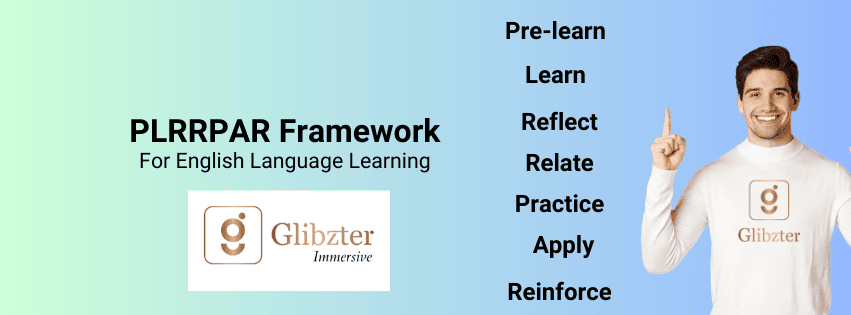The PLRRPAR framework offers a dynamic learner-centered approach empowering English learners to acquire and confidently apply language skills in the real-world contexts. This microblog explores each of its seven phases in relationship with Glibzter Immersive - English Vocabulary Builder to assess how it addresses challenges related to language acquisition, motivation to learn, holistic skill development and confidence in application.

P for Pre-learn by building background knowledge
Learners are exposed to authentic materials in the form of texts, dialogues and multimedia resources, promoting immersive learning and nurturing interest and motivation for further language exploration.
This foundational phase is meant to equip learners with context setting, thus prepping their minds to know what to expect and experience. It is tantamount to watching the trailer/ teaser of a movie or the headline/ sub-head/ abstract of a news article. It aims to bridge prior knowledge about a subject and its associated vocabulary, grammar, sentence structures and pronunciation with new language components in the new materials.
L for Learn by active engagement and instructional delivery
The second phase is about the learners' active engagement with the learning resources in the form of acquisition of words and phrases, observing how they are pronounced along with studying sentence structures, exploring the context in which they are used and their meaning. The aim is to enhance comprehension while consuming the content in the materials (be it multimedia resources, books, newspapers or magazines).
R for Reflect through metacognitive awareness
During the third phase, learners interpret the content they consume from the resource materials (OTT videos with subtitles and online news articles as in the case of Glibzter Immersive - English Vocabulary Builder) and link situations they come across as well as the newly acquainted English words and phrases with self experienced real-life situations and emotions. Facilitating this metacognitive awareness will ensure the 'stickiness' of the newly acquired words and phrases.

R for Relate components of English language skills
English language skills include components such as listening, speaking, reading and writing besides vocabulary and grammar. How you read will determine how you express yourself through speech and writing. How you listen will determine how you comprehend and respond to what is said to you.
While learning new words and phrases using Glibzter Immersive browser extension (available for Google Chrome and Microsoft Edge) and web app, you will learn by context, situation and emotion through usage examples in the form of sentences. Through listening to these sentences (audio feature) and reading them, you understand the application of grammar in the sentence structure. Learners can make the most of this phase by reading the usage example sentences of words and phrases, listening to how the sentences sound, writing them out and finally speaking them during social interactions, thereby improving their LSRW skills.
P for Practice - Repetition improves accuracy
While using Glibzter Immersive - English Vocabulary Builder, once the words and phrases are automatically curated and presented to you, you need to practice them contextually - i.e. by situation and emotion, besides acquainting yourself with word substitutes (synonyms) and word combinations (collocations).
Most language learning apps like Duolingo have introduced the concept of 'spaced repetition' i.e. being presented with the word or phrase, its meaning and usage example along with a couple of gamified assessments spread across a period of time e.g. the next day, 3 days later, 10 days later, 15 days and 30 days later so as to improve mental retention. With increased practice, learners will start using the words and phrases more accurately, leading to greater comfort and confidence in real-life communicative situations.
A for Apply - Real-life communication situations
The sixth phase will need the learners to apply their knowledge of the topics they have learn as well as the language skills they have amassed in their personal, social and professional environments. The biggest challenge however is that of hesitation or lack of initiative to engage despite knowing what to speak or write.
The more qualitative and frequent the practice, the better would be the outcome in this phase.
If you use Glibzter Immersive - English Vocabulary Builder, we encourage you to share usage examples in the form of social media posts (text posts on Facebook or X.com, and then graduating to reels on Instagram). This is more of a shadow practice application before getting to engage with a larger audience through speech.
R for Reinforce - Making it a lifelong learning process
Reinforcement involves revisiting and creatively applying previously learnt language skills (especially contextual usage of words and phrases) through recall while watching other movies, reading news and taking part in assessments (solving word puzzles or playing word games). This is the phase wherein, if you are used to using a particular word to describe a situation, you should tune yourself to using synonyms of that word to become more creative and engaging in spoken English.
This phase should also make learners realize that English language learning is a lifelong cognitive process, wherein it should be an objective to learn something new everyday.
Glibzter's Take
As you can see, our product, Glibzter Immersive has been developed based on the PLRRPAR framework for the most part. The framework provides a systematic language acquisition path for learners, while being complemented by Glibzter Immersive serving as their digital English vocabulary coach curating words and phrases of relevance from the content they consume online.
The role of English language teachers in this process is pivotal to the successful implementation of the framework, thereby going to highlight the fact that both edtech and AI can best complement and can never ever replace the central role played by teachers as facilitators.


